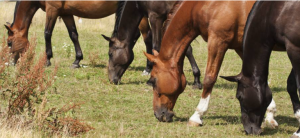 Managing Horses on Declining Pasture: As the growing season winds down or as drought sets in, horse owners must provide horses with an appropriate alternative forage to fulfill fiber requirements. In most cases, this involves the use of hay. Although other products such as haylage or hay cubes are appropriate and sometimes fed.
Managing Horses on Declining Pasture: As the growing season winds down or as drought sets in, horse owners must provide horses with an appropriate alternative forage to fulfill fiber requirements. In most cases, this involves the use of hay. Although other products such as haylage or hay cubes are appropriate and sometimes fed.
The question that looms large for most owners is when to offer alternative forage. The pasture reveals a couple of important clues, namely growth rate and plant health.
Pasture Tips:
Owners will know when pasture growth slows as there will be less need for routine mowing and maintenance. Depending on stocking rate—that is, the number of horses on any given acreage—pasture might withstand a slowdown in growth rate and continued grazing. So long as more land is allotted per horse. A large, seven-acre paddock that comfortably sustained five horses in peak growing season might support three as pasture growth declines.
“Observation of grazing behavior might be a tipoff, too. If horses spend more time grazing, they are likely finding less to eat. In periods of lush growth, you might catch horses resting more often. It is easier for them to satisfy their appetites and their need to graze,” said Kathleen Crandell, Ph.D., a nutritionist with Kentucky Equine Research (KER).
Plant health is a more obvious indicator. As autumn segues into winter or as rainfall decreases, pasture grasses often turn brown and unpalatable. During this time growth is almost assuredly arrested. Horses will snack on these remnants, but more nutritious forage should be offered.
Supplementation:
“Owners ought to offer hay as soon as they feel horses are not consuming sufficient pasture to meet daily forage requirement, which is about 1.5-2% of body weight daily,” advised Crandell.
For a 15.2-hand, 1,100-lb (500-kg) horse, that would be 16.5-22 lb (7.5-10 kg) of hay each day. Keep in mind, though, that this amount will likely satisfy the horse’s complete forage requirement.
“If the horse is still nibbling away at pasture much of the day, it might need only a portion of this. If the horse leaves hay in favor of pasture, then too much hay is probably being fed at the time. Gauge requirement through consumption,” recommended Crandell.
To maintain weight, many horses, in combination with their forage, will be consuming a well-fortified concentrate feed that supplies all of the protein, vitamins, and minerals required for their well-being. Those that do not should be fed a vitamin and mineral supplement. For example, Micro-Max, developed by Kentucky Equine Research and available in the U.S. and other regions. Micro-Max supplies minerals that have been chelated or proteinated, which increases their digestibility and allows horses to derive maximum benefit from them. Horse owners in Australia should look for Gold Pellet, Nutrequin, or Perform.
One vitamin that is particularly deficient in diets composed of preserved forages such as hay is vitamin E, an important antioxidant in the horse’s immune arsenal. The most effective source of supplemental vitamin E is d-alpha-tocopherol or natural vitamin E. Nano-E is a natural-source vitamin E supplement. It possesses a unique delivery action, nanodispersion. Consequently, this allows the vitamin to hit target tissues more quickly than other vitamin E supplements. Nano-E is available worldwide.
Don’t know where to begin with supplementation?
J & J Hay can help to answer horse-health and hay related questions.
Source: Kentucky Equine Research
